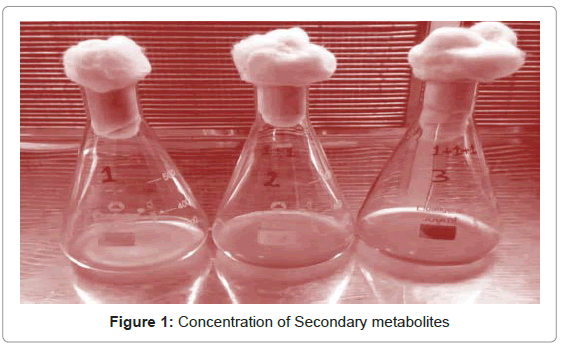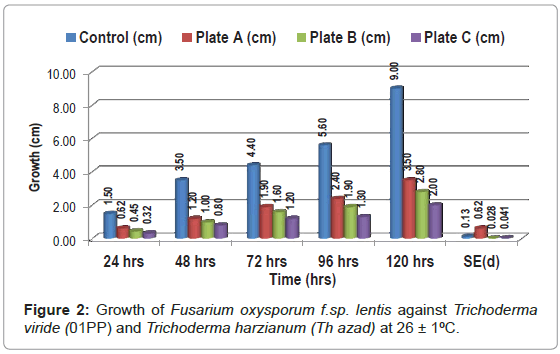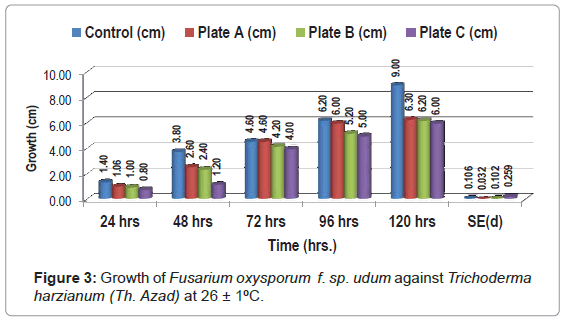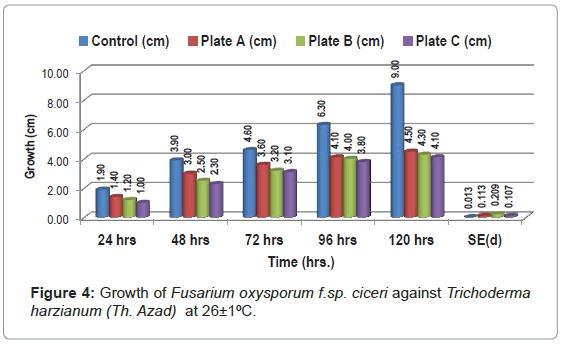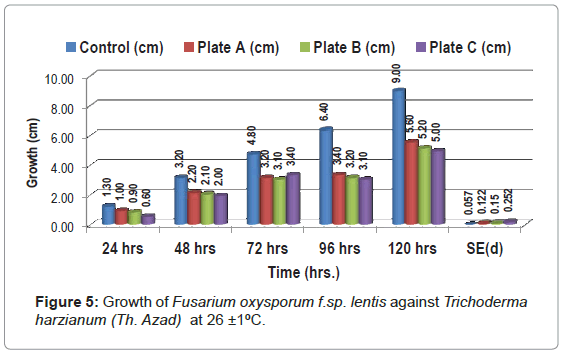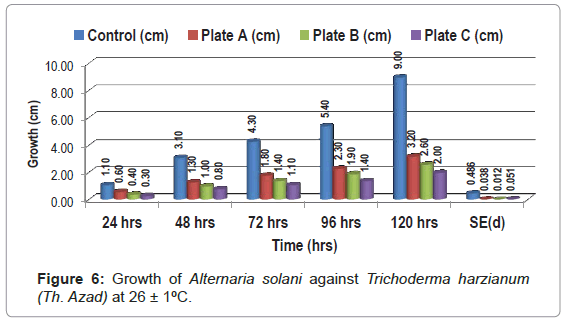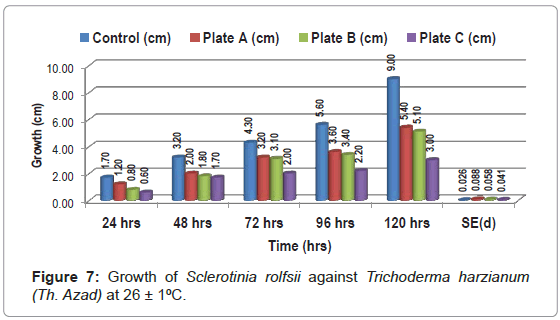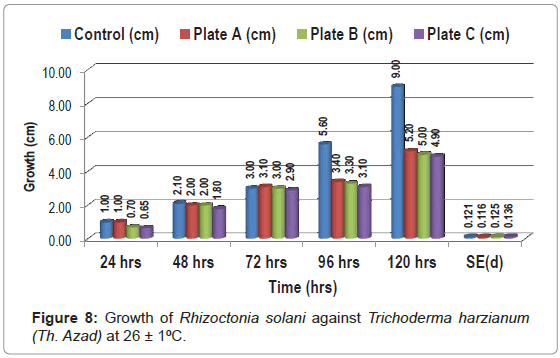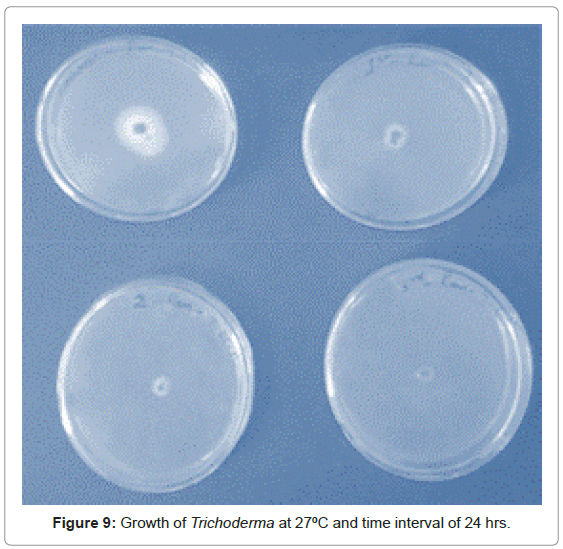Research Article Open Access
Role of Secondary Metabolites Produced by Commercial Trichoderma Species and their Effect Against Soil Borne Pathogens
Vipul Kumar*, Mohammad Shahid, Mukesh Srivastava, Sonika Pandey, Anuradha Singh and Antima Sharma
Biocontrol Laboratory,Department of Plant Pathology, C.S. Azad University of Agriculture and Technology, Kanpur, UP, India
- Corresponding Author:
- Vipul Kumar
Biocontrol Laboratory, Department of Plant Pathology
C.S.Azad University of Agriculture and Technology, Kanpur, UP, India
Tel: 0512 253 4156
E-mail: vipulpathology@gmail.com
Received Date: April 09, 2014; Accepted Date: August 26, 2014; Published Date: September 05, 2014
Citation: Vipul K, Mohammad S, Muksesh S, Sonika P, Anuradha S, et al. (2014) Role of Secondary Metabolites Produced by Commercial Trichoderma Species and their Effect Against Soil Borne Pathogens. Biosens J 3:108. doi:
Copyright: © 2014 Vipul K, et al. This is an open-access article distributed under the terms of the Creative Commons Attribution License, which permits unrestricted use, distribution, and reproduction in any medium, provided the original author and source are credited.
Visit for more related articles at Biosensors Journal
Abstract
The study was focused on the identification of the major secondary metabolites produced by the Trichoderma spp and soil borne pathogens. Trichoderma harzianum (Th. Azad) and Trichoderma viride (01PP) are two microorganisms used as active agents in a variety of commercial bio pesticides and bio fertilizers and widely applied on field and greenhouse crops. The production, isolation, biological and chemical characterization of the major secondary metabolites produced by these strains is done during this study. Metabolites are organic compounds that are used in, or created by, the chemical reactions happening in every cell of living organisms. In this paper we are studying about the production of secondary metabolites from Trichoderma species against soil borne pathogens at 27oC at different time intervals. Higher the concentration of secondary metabolites, greater will be the efficiency against soil borne pathogens
Keywords
Secondary metabolites; Trichoderma; Soil borne pathogens
Introduction
The biocontrol mechanism of Trichoderma spp. is a complex process mediated by the secretion of extracelluar enzymes, such as chitinase, β- glucanase and proteinases, as well as secondary metabolites. Although some antibiotics may be the major factor for the biocontrol activity of certain strain, this may not be the case of others. In addition, there is still no clear evidence on the production of antibiotic compounds by Trichoderma spp. in the rhizosphere. Metabolites are organic compounds that are used in, or created by, the chemical reactions happening in every cell of living organisms [1]. This process, known as metabolism, is responsible for breaking down food and other chemicals into energy and materials needed for health, growth, and reproduction. Metabolism is also responsible for the removal of toxic substances from the body. Metabolites can be the starting materials, intermediate materials, or end products of these chemical reactions. A variety of metabolites and reactions combine to produce all the effects that allow an organism to sustain life. A primary metabolite is a kind of metabolite that is directly involved in normal growth, development, and reproduction. The main primary metabolites are carbohydrates, proteins, nucleic acids, and lipids. Secondary metabolites are organic compounds that are not directly involved in the normal growth, development, or reproduction of an organism. Unlike primary metabolites, absence of secondary metabolites does not result in immediate death, but rather in long-term impairment of the organism's survivability, fecundity, or aesthetics, or perhaps in no significant change at all. Secondary metabolites often play an important role in plant defense against herbivores and other interspecies defenses. Humans use secondary metabolites as medicines, flavorings, and recreational drugs. The main secondary metabolites are alkeloids, terpenoids, phenolics etc.
Trichoderma spp. [2] are fungi that are present in nearly all soils and other diverse habitats. In addition to colonizing roots, Trichoderma spp. attack, parasitize and otherwise gain nutrition from other fungi [3]. Several new general methods for both bio control and for causing enhancement of plant growth have recently been demonstrated [4] and it is now clear that there must be hundreds of separate genes and gene products involved in this processes. Trichoderma spp. possess innate resistance to most agricultural chemicals, including fungicides [5] although individual strains differ in their resistance. Soil borne pathogens is a fungal pathogen, producing a disease in tomato and potato plants called early blight. It produces small, darkened lesions on the plants that spread into growing black spots of dead tissue, often killing most of the plant in the long run. Seeds infected with the disease may even damp off during germination.
Materials and Methods
Media preparation
TSM (Trichoderma Selective Media) contains 0.2 g MgSO4.7H20, 0.9 g K2HPO4, 0.15 g KCl, 3.0 g NH4NO3, 3.0 g Dextrose, 0.25 g Chloramphenicol, 0.305 g, Fenaminosulf, 0.20 g PCNB, 0.15 g Rose Bengal, 1000 ml distilled water, 18.0 g AGAR. After that pH were adjusted 7.0. PCNB has been added after autoclaving of media. After the media preparation it has been kept in autoclave machine for 30 min at 121ºC. Then serial dilution has been done, for serial dilution three samples of soils has been taken. The samples from which soil has been taken are Rofflia serpentine, Parthenium and Carissa carandus. From 10-4, 10-5, 10-6 dilution vials 100 μl sample has been taken and spread on the TSM plate. After 2-3 days Trichoderma growth has been observed. The colour of colony is green. Potato Dextrose Broth contains 100 g Potato, 10 g dextrose, 500 ml distilled water and pH was adjusted 6.0. After the broth is prepared, six conical flasks of 500 ml is taken and 50 ml broth is poured in each flask. After that each broth has been kept in autoclave machine for 30 min at 121°C and 15 psi. An autoclaved broth is taken and kept into Laminar Air Flow for the inoculation of Trichoderma and soil borne pathogens into each flask. Then the flask is kept for 5 days at room temperature. After 5 days all the six conical flask is kept at shaker for 1 week for better mixing. After this long term process the broth is filtered with sterile 0.22 micron filter paper. For getting higher concentration of secondary metabolites we will make three different volume of broth by mixing two flask media into one and three flask media into one. Now we have three broth which is indicated as 1st, 2nd, 3rd. The fresh broth is prepared which will work as control. 2 g of agar is added is added into each flask and all the four broth is kept to autoclave machine for 30 min at 121°C. Pour the 1st, 2nd, 3rd and Control media into 1st, 2nd, 3rd and CONTROL written sterile petri plates respectively and inoculate the pathogen in all plates. After the inoculation the plates are incubated at 27°C and the growth is recorded after 24 hrs every day.
Results
Trichoderma species is filamentous fungi with high economic importance since it participate as biological control or biological pesticide agents, inhibiting the growth of phytopathogenic fungi that could destroy a large variety of crops. Result showed that secondary metabolites play an efficient role in inhibiting the growth of the pathogen. From the above study it is evident that with the increase in the concentration of metabolites the growth of the pathogen decreases Figures 1-9 and Tables 1-7, hence higher the concentration of secondary metabolites, greater will be the efficiency against pathogen.
| Time | Control (cm) | Plate A (cm) | Plate B (cm) | Plate C (cm) |
|---|---|---|---|---|
| 24 hrs | 1.50 | 0.62 | 0.45 | 0.32 |
| 48 hrs | 3.50 | 1.20 | 1.00 | 0.80 |
| 72 hrs | 4.40 | 1.90 | 1.60 | 1.20 |
| 96 hrs | 5.60 | 2.40 | 1.90 | 1.30 |
| 120 hrs | 9.00 | 3.50 | 2.80 | 2.00 |
| SE(d) | 0.130 | 0.620 | 0.028 | 0.041 |
Table 1: Growth of Fusarium oxysporum f.sp. lentis against Trichoderma viride (01PP) and Trichoderma harzianum (Th azad) at 26 ± 1°C.
| Time | Control (cm) | Plate A (cm) | Plate B (cm) | Plate C (cm) |
|---|---|---|---|---|
| 24 hrs | 1.40 | 1.06 | 1.00 | 0.80 |
| 48 hrs | 3.80 | 2.60 | 2.40 | 1.20 |
| 72 hrs | 4.60 | 4.60 | 4.20 | 4.00 |
| 96 hrs | 6.20 | 6.00 | 5.20 | 5.00 |
| 120 hrs | 9.00 | 6.30 | 6.20 | 6.00 |
| SE(d) | 0.106 | 0.032 | 0.102 | 0.259 |
Table 2: Growth of Fusarium oxysporum f. sp.udum against Trichoderma harzianum (Th. Azad) at 26 ± 1°C.
| Time | Control (cm) | Plate A (cm) | Plate B (cm) | Plate C (cm) |
|---|---|---|---|---|
| 24 hrs | 1.90 | 1.40 | 1.20 | 1.00 |
| 48 hrs | 3.90 | 3.00 | 2.50 | 2.30 |
| 72 hrs | 4.60 | 3.60 | 3.20 | 3.10 |
| 96 hrs | 6.30 | 4.10 | 4.00 | 3.80 |
| 120 hrs | 9.00 | 4.50 | 4.30 | 4.10 |
| SE(d) | 0.013 | 0.113 | 0.209 | 0.107 |
Table 3: Growth of Fusarium oxysporum f.sp. ciceri against Trichoderma harzianum(Th. Azad) at 26 ± 1°C.
| Time | Control (cm) | Plate A (cm) | Plate B (cm) | Plate C (cm) |
|---|---|---|---|---|
| 24 hrs | 1.30 | 1.00 | 0.90 | 0.60 |
| 48 hrs | 3.20 | 2.20 | 2.10 | 2.00 |
| 72 hrs | 4.80 | 3.20 | 3.10 | 3.40 |
| 96 hrs | 6.40 | 3.40 | 3.20 | 3.10 |
| 120 hrs | 9.00 | 5.60 | 5.20 | 5.00 |
| SE(d) | 0.057 | 0.122 | 0.150 | 0.252 |
Table 4: Growth of Fusarium oxysporum f.sp. lentis against Trichoderma harzianum (Th. Azad) at 26 ± 1°C.
| Time | Control (cm) | Plate A (cm) | Plate B (cm) | Plate C (cm) |
|---|---|---|---|---|
| 24 hrs | 1.10 | 0.60 | 0.40 | 0.30 |
| 48 hrs | 3.10 | 1.30 | 1.00 | 0.80 |
| 72 hrs | 4.30 | 1.80 | 1.40 | 1.10 |
| 96 hrs | 5.40 | 2.30 | 1.90 | 1.40 |
| 120 hrs | 9.00 | 3.20 | 2.60 | 2.00 |
| SE(d) | 0.486 | 0.038 | 0.012 | 0.051 |
Table 5: Growth of Alternaria solani against Trichoderma harzianum (Th. Azad) at 26 ± 1°C.
| Time | Control (cm) | Plate A (cm) | Plate B (cm) | Plate C (cm) |
|---|---|---|---|---|
| 24 hrs | 1.70 | 1.20 | 0.80 | 0.60 |
| 48 hrs | 3.20 | 2.00 | 1.80 | 1.70 |
| 72 hrs | 4.30 | 3.20 | 3.10 | 2.00 |
| 96 hrs | 5.60 | 3.60 | 3.40 | 2.20 |
| 120 hrs | 9.00 | 5.40 | 5.10 | 3.00 |
| SE(d) | 0.026 | 0.088 | 0.058 | 0.041 |
Table 6: Growth of Sclerotinia rolfsii against Trichoderma harzianum (Th. Azad) at 26 ± 1°C.
| Time | Control (cm) | Plate A (cm) | Plate B (cm) | Plate C (cm) |
|---|---|---|---|---|
| 24 hrs | 1.00 | 1.00 | 0.70 | 0.65 |
| 48 hrs | 2.10 | 2.00 | 2.00 | 1.80 |
| 72 hrs | 3.00 | 3.10 | 3.00 | 2.90 |
| 96 hrs | 5.60 | 3.40 | 3.30 | 3.100 |
| 120 hrs | 9.00 | 5.20 | 5.00 | 4.90 |
| SE(d) | 0.121 | 0.116 | 0.125 | 0.136 |
Table 7: Growth of Rhizoctonia solani against Trichoderma harzianum (Th. Azad) at 26 ± 1°C
The biological control ability of Trichoderma species seems to be due to multiple factors, as they have the ability to produce a variety of extracellular lytic enzymes and the production of many secondary metabolites and these metabolites are also believed to participate in induction of plant defense responses we have analyzed the plant responses at the level of CWDE gene expression in the interaction with mutant in order to establish the role of these compounds during the symbiosis. Three kinds of compounds are mainly produced by strains of Trichoderma i.e. peptaibols, polyketides and terpenes. Some of them have antifungal activity.
The biocontrol mechanism of Trichoderma species is a complex process mediated by the secretion of extracellular enzymes, such as chitinases, β-glucanases and proteinases, as well as secondary metabolites. Although some antibiotics may be the major factor for the biocontrol activity of a certain strain, this may not be the case for others. In addition, there is still no clear evidence on the production of antibiotic compounds by Trichoderma spp. in the rhizosphere.
The study was focused on the identification of the major secondary metabolites produced by Trichoderma species against Soil borne pathogens. In the in vitro interactions between species and soil borne pathogens, it is observed that secondary metabolites play an efficient role in inhibiting the growth of the pathogen. Higher the concentration of secondary metabolites, greater will be the efficiency against pathogen.
The result shows the positive effect of secondary metabolites of Trichoderma species against soil borne pathogens. So instead of using Trichoderma spp. we can use their secondary metabolites. This positive effect of secondary metabolites is a boon for agriculture. By the mass production of these secondary metabolites it can be used at large scale by which the production of crop will increase.
Discussion
Studies on the secondary metabolites isolated from T22 and T39 strains supported by a ‘metabolomic approach’ [6] are required to better our understanding of both the mechanisms of action of these bioactive compounds during the antagonism and their role in the interaction between biocontrol fungi, plant and microbial pathogens. The bio control mechanism of Trichoderma harzianum is a complex process mediated by the secretion of extracellular enzymes, such as chitinases [7] b-glucanases [8] and proteinases [9] as well as secondary metabolites [10]. The role of Trichoderma antibiotics in biocontrol is still a matter of discussion. Although some antibiotics may be the major factor for the biocontrol activity of a certain strain, this may not be the case for others [11]. In addition, there is still no clear evidence on the production of antibiotic compounds by Trichoderma spp. in the rhizosphere and spermosphere [12].
Our results support the consideration that the antibiosis occurring during the saprophytic and antagonistic growth of strains Th. azad and 01 PP could be involved, in concert with other mechanisms, during the interaction with plant pathogens [13]. Furthermore, T. harzianum is a well-known producer of cell wall-degrading enzymes and the antibiotics could act synergistically with them [14,15]. Similar work on major secondary metabolites produced by Trichoderma species also concluded by [16,17] reported that Tricoderma isolates are more effective and show excellent control of S. rolfsii, responsible for groundnut rot. These isolates could be exploited on a large scale for field application in local conditions. The two isolates will be promising bio control agents against rots caused by S. rolfsii in field crops with best outcome in future plant biotech applications. Barbara [18] also reported that Secondary metabolite toxins produced by fungi often play a role in triggering these responses [19] suggested that plants protect themselves by producing some compounds called as secondary metabolites. Secondary metabolites, including terpenes, phenolics and nitrogen (N) and sulphur (S) containing compounds, defend plants against a variety of herbivores and pathogenic microorganisms as well as various kinds of abiotic stresses [20] observed that the antagonists produce an array of secondary metabolites such as antibiotics and toxin, which contribute to the antagonistic activity of fungal biocontrol agents against plant pathogens. Antagonistic strains belonging to the Trichoderma and Fusarium genera were able to produce various secondary metabolites which can play a role in the mechanism of their biological activity [21-23].
Conclusion
This paper reports the isolation and characterization of the main secondary metabolites obtained from culture filtrates of two Trichoderma strains (Th. Azad & 01 PP) and their production during antagonistic interaction with soil borne pathogens. This work is done on the secondary metabolites produced by the commercially applied strains Th. azad and 01 PP. Our results provide a better understanding of the metabolism of these fungi, which are both widely used as biopesticides and/or biofertilizers in biocontrol.
Acknowledgements
The authors are grateful for the financial support granted by the ICAR under the Niche Area of Excellence on “Exploration and Exploitation of Trichoderma as an antagonist against soil borne pathogens” running in the Bio-control Laboratory, Department of Plant Pathology, C.S.A University of Agriculture and Technology, Kanpur, India.
References
- Mumpuni A, Sharma HSS, Averil EB (1998) Effect of metabolites produced by Trichodermaharzianum biotypes and Agaricusbisporus on their respective growth radii in culture. ApplEnvironmenMicrobiol 64:5053-5056.
- Hermosa MR, Grondona I, Iturriaga EA, Diaz-Minguez JM,Castro C, et al.(2000) Molecular Characterization and Identification of Biocontrol Isolates of Trichoderma spp.Appl Environ Microbiol 66: 1890-1898.
- Yedidia I, Benhamou N, Chet I (1999) Induction of Defense Responses in Cucumber Plants (Cucumissativus L.) by the Biocontrol Agent Trichodermaharzianum. Appl Environ Microbiol 65: 1061-1070.
- Angela R, Luz MP (2001) In vitro biocontrol activity of Trichodermaharzianum on Alternariaalternata in the presence of growth regulators. J Biotechnol 4:3458.
- Ranasingh N, Saurabh A, Nedunchezhiyan M (2006) Use of Trichoderma in Disease Management. Orissa Review 68-70.
- Weckwerth W, Fiehn O (2002) Can we discover novel pathways using metabolomic analysis? CurrOpinBiotechnol 13:156-160.
- De la Cruz J, Hidalgo GA, Lora JM, Benitez T, Pintor T, et al. (1992) Isolation and characterization of three chitinases from Trichodermaharzianum. Eur J Biochem 206:859-867.
- Barbara JH(2006) Secondary metabolite toxins and nutrition of plant pathogenic fungi. Current Opinion in Plant Biology 9:371-375.
- Geremia RA, Goldman GH, Jacobs D, Ardiles W, Vila SB, et al. (1993) Molecular characterization of the proteinase-encoding gene, prb1, related to mycoparasitism by Trichodermaharzianum. MolMicrobiol 8:603-613.
- Harman GE, Howell CR, Viterbo A, Chet I,Lorito M (2004) Trichodermaspecies – opportunistic, avirulent plant symbionts. Nat Rev Microbiol 2:43-56.
- Sivasithamparam K, Ghisalberti EL (1998) Secondary metabolism in Trichoderma and Gliocladium, vol. 1 ed. Harman, G.E. and Kubicek, C.P. London: Taylor and Francis Ltd. pp. 139-191.
- Elad Y (2000) Trichodermaharzianum T39 preparation for biocontrol of plant diseases –control of Botrytis cinerea, Sclerotiniasclerotiorum and Cladosporiumfulvum. Biol Control 10: 499-507.
- Whipps JM (2001) Microbial interactions and biocontrol in the rhizosphere. J Exp Bot 52:487-511.
- Howell CR (1998) The role of antibiosis in biocontrol In Trichoderma and Gliocladium, vol. 2 ed. Harman, G.E. and Kubicek, C.P. pp. 173-183. London: Taylor and Francis Ltd.
- Schirmbock M, Lorito M, Wang YL, Hayes CK, ArisanAtac I, et al. (1994) Parallel formation and synergism of hydrolytic enzymes and peptaibol antibiotics, molecular mechanisms involved in the antagonistic action of Trichodermaharzianum against phytopathogenic fungi. Appl Environ Microbiol 60:4364-4370.
- Lorito M, Farkas V, Rebuffat S, Bodo B, Kubicek CP (1996) Cell wall synthesis is a major target of mycoparasitic antagonism by Trichodermaharzianum. J Bacteriol 178:6382-6385.
- Vinale F, Marra R, Scala F, Ghisalberti EL, Lorito M, etal. (2006) Major secondary metabolites produced by two commercial Trichodermastrains active against different phytopathogens.LettApplMicrobiol 43:143-148
- Padmaja M, Narendra K, Swathi J, Sowjanya KM, JawaharBabu P (2013) In Vitro Antagonism of Native Isolates of Tricodermaspp Against Sclerotiumrolfsii.Int J Res Pharma and Biomed Sci 4:886-891.
- Lorito M, Hayes CK, Woo SL, Harman GE (1994) Purification, characterization and synergistic activity of a glucan 1,3-b-glucosidase and an N-acetyl-bglucosaminidase from Trichodermaharzianum. Phytopathology 84:398-405.
- Mazid M, Khan TA, Mohammad F (2011) Role of secondary metabolites in defense mechanisms of plants. Biology and Medicine3: 232-249.
- MathivananN, Prabavathy VR,Vijayanandraj VR (2008) The Effect of Fungal Secondary metabolites on Bacterial and Fungal Pathogens.Soil Biology14:129-140.
- Singh R, Rakshita, Khare R, Pandey J, Khare S(2012)Production and evaluation of secondary metabolites of Trichoderma harzianumagainst Alternaria solani. J ChemBioandPhySci2:1308-1311.
- Tariq MB, Chris J, Naresh MFungi as a biocontrol agent-progress, problem and Potential Research Institute, Dumduma, Bhubaneswar – 751.
Relevant Topics
- Amperometric Biosensors
- Biomedical Sensor
- Bioreceptors
- Biosensors Application
- Biosensors Companies and Market Analysis
- Biotransducer
- Chemical Sensors
- Colorimetric Biosensors
- DNA Biosensors
- Electrochemical Biosensors
- Glucose Biosensors
- Graphene Biosensors
- Imaging Sensors
- Microbial Biosensors
- Nucleic Acid Interactions
- Optical Biosensor
- Piezo Electric Sensor
- Potentiometric Biosensors
- Surface Attachment of the Biological Elements
- Surface Plasmon Resonance
- Transducers
Recommended Journals
Article Tools
Article Usage
- Total views: 17503
- [From(publication date):
December-2014 - Aug 16, 2025] - Breakdown by view type
- HTML page views : 12463
- PDF downloads : 5040

